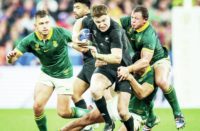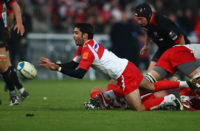Back in the dim and distant, in an arty-farty corner of the newsroom at the Bristol Evening Post, there lurked a features editor who was left so cold by Rugby Union and pretty much everything associated with it, he refused to discuss the subject unless he was wearing a fur coat.
His response to England's tour of apartheid South Africa in 1984 – which turned out to be the last, not before time – was positively Arctic. Twickenham had shown the moral compass of a newt in sanctioning the trip in the first place, he argued, and the frequent outbreaks of mass fisticuffs were a stain on the name of sport.
“One other thing,” he said, reflecting on the height and poundage of some of the Springboks who had reduced John Scott and his countrymen to their component parts in a two-Test series of the most one-sided variety, winning the try count 9-0.
“The way rugby is going, it will soon be a game for physical freaks.”
This journalistic Cassandra was onto something. More than a decade before professionalism, full-time training, 24/7 strength and conditioning programmes and the obligatory protein shakes, he foresaw a time when rugby's Davids – the Didier Codornious of the 80s and the Arwel Thomases of the future – would be rendered unselectable by its Goliaths.
All this sprang to mind a little over a week ago, as the La Rochelle flanker Kevin Gourdon was inflicting his sophisticated brand of thinking man's rugby on Gloucester in the Champions Cup tie at Kingsholm and making the West Countrymen look like a bunch of know-nothings with his geometer's eye for the optimum running line and the super-soft subtlety of his handling skills.
Gourdon, constructed on a generous scale by any normal standard, made his international debut in 2016 and was the stand-out French performer in the following year's Six Nations. Yet he was off the radar by the time the World Cup in Japan came around, losing out to a variety of rivals who were either bigger, or more direct, or both, and has not played Test rugby in almost three years, more's the pity.
It is the spirit of the age, not least in England, where successive coaches embraced a philosophy in which physicality and aggression were the measures of all things. Leaving aside Sam Burgess (if only Stuart Lancaster had done so!), was Mike Brown really a better game-turning No.15 than Alex Goode, or simply one more capable of turning a game into a fight?
For those sufficiently long in the tooth, there was a foreshadowing of what might be called the Gourdon Syndrome in the 1990s, before and after the World Cup in South Africa that changed the game for ever and ever, amen. The coach at the centre of it was Jack Rowell. The player was one of his own: Andy Robinson.
When he was guiding Bath to every trophy under the sun over the course of a golden decade, Rowell understood the importance of Robinson's many talents: his industry, his abnormally high pain threshold and his willpower, together with a range of footballing attributes that set him apart from the common herd of openside specialists.
Yet when he succeeded Geoff Cooke as England coach, Jack decided the international arena was no place for a squirt like Robbo – or Neil Back of Leicester, or Derek Eves of Bristol – and went for the “uber” options instead.
Tim Rodber, Ben Clarke, Dean Richards and Steve Ojomoh were his back rowers of choice. If you wanted to play No.7 for your country, you had to be a No.8.
This strategy turned to dust when England encountered Josh Kronfeld in the 1995 World Cup semi-final and spent the whole game trying to fathom why the surf-nut ecowarrior from the South Island of New Zealand was playing his rugby in a different half of the field.
All three of Rowell's loosies were twice the size of Kronfeld. To which Kronfeld, as quick of mind as he was fleet of foot, shrugged his shoulders. He may also have said “Whoopee Doo” under his breath, but hard evidence remains elusive.
Suitably chastened, Rowell immediately recalled his old go-to flanker for England's first post-World Cup fixture, against the new champions South Africa at Twickenham.
Bath had been using him as the fourth member of a midfield quartet – a radical tactical departure rooted in his ability as a distributor – but there was no such adventure against the Springboks, who rubbed Red Rose noses in it all afternoon and ended Robinson's international career there and then.
A quarter of a century on, big is more beautiful than ever. If the great 2015 All Blacks' successful defence of the world title featured a number of players of comparatively modest human dimensions – the holy trinity of brilliant backline Smiths, the halfpint wing Nehe Milner-Skudder, some bloke by the name of Carter – the trend is very much otherwise.
One-size-fits-all “rucks” have led to identikit breakdown techniques; Rugby League defensive systems eat up space faster than rapacious housing developers; props make more tackles than centres; centres are as big as flankers.
As a result, the Kevin Gourdons of this world are an endangered species. Where's David Attenborough when you need him?
CHRIS HEWETT



























